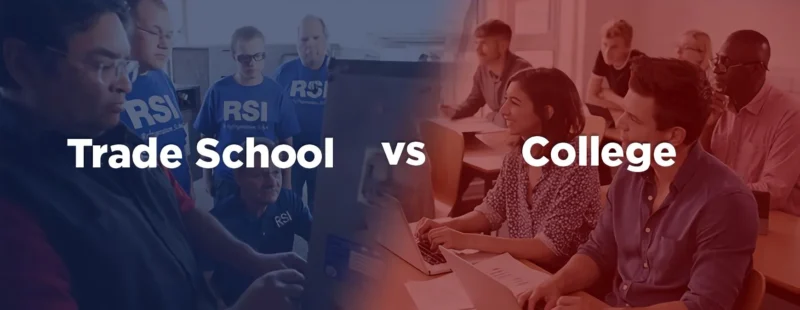For many, the thought of pursuing higher education sparks questions about cost, time, and job prospects. With college degrees often perceived as the gold standard, trade-focused paths are often overlooked. But is that perception outdated? Could a trade school degree pave the way for a stable, fulfilling career? The answer might surprise you.
Key Points
- Trade schools focus on job-specific skills.
- Many careers from trade schools offer stability and growth.
- Trade school graduates often face less student debt.
- Hands-on experience prepares students for immediate employment.
- Growing industries are increasingly hiring trade school graduates.
What Makes Trade Schools a Viable Option?

Trade schools provide hands-on training for specific industries. Unlike traditional colleges, they emphasize practical skills that can translate directly into employment. Mike Feinberg, co-founder of KIPP Charter Schools, highlights this shift in education through innovative programs.
Speaking with the Texas Public Policy Foundation, Feinberg discussed how WorkTexas and similar initiatives equip students with life-changing skills for careers that don’t require a college degree. These programs prove that specialized learning can be just as valuable, if not more, than a traditional academic route.
Many graduates have proven the value of trade-focused education. Programs like WorkTexas showcase how tailored training changes lives. Students not only gain job-ready skills but also develop confidence and independence. Success stories from programs like these inspire others to consider non-traditional paths.
Career Options Beyond a Four-Year Degree

Some assume that trade school options are limited to manual labor or blue-collar roles. In reality, programs cover a wide range of industries, including:
- Healthcare Support: Dental hygienists and medical technologists often start with certificates.
- Technology: Jobs in coding and IT support frequently value skill certifications over degrees.
- Skilled Trades: Electricians, welders, and HVAC technicians remain in high demand.
- Creative Professions: Culinary arts, graphic design, and media production offer lucrative paths.
These fields offer stability, advancement opportunities, and salaries that often compete with or exceed those requiring a four-year degree.
Cost Comparison: Trade Schools vs. College
Cost plays a significant role in education decisions. Trade schools typically cost less than traditional colleges. A typical program might range from $5,000 to $15,000, compared to the tens of thousands spent on a bachelor’s degree. Lower tuition means graduates often face less debt, allowing them to begin building wealth sooner.
Key Advantages of Lower Costs:
- Fewer loans mean faster financial independence.
- Affordable programs open access to more individuals.
- Graduates can reinvest savings into tools or continuing education.
How Long Does It Take to Graduate?

Trade programs are often shorter, ranging between six months and two years. This allows students to enter the workforce quickly. For comparison:
- Automotive technicians complete programs in 6–12 months.
- Medical assistants finish in about one year.
- Electricians often begin apprenticeships within two years.
This shorter timeline appeals to those eager to start earning without extended delays.
Job Security and Demand
Jobs linked to trade education often provide greater stability during economic fluctuations. Industries like healthcare, technology, and skilled trades consistently require trained professionals.
Fast-Growing Fields:
- Renewable Energy: Solar and wind technicians are seeing rapid demand.
- Healthcare: With aging populations, medical-related careers remain critical.
- Construction: Infrastructure projects create ongoing opportunities.
Unlike roles that require a traditional degree, trade-focused jobs often have less competition due to a smaller talent pool.
Setting the Record Straight About Trade Schools

Many misconceptions exist about trade-focused education. Let’s address a few:
- Myth: Trade school jobs are low-paying.
Reality: Careers like plumbing or radiologic technology often start with salaries above $50,000 annually. - Myth: Trade school limits career advancement.
Reality: Certifications and licenses allow for growth and specialization. - Myth: Trade schools are for those who can’t succeed academically.
Reality: Success in practical programs requires dedication, focus, and skill.
Benefits of Hands-On Experience
Practical learning methods allow students to apply skills immediately. Internships, apprenticeships, and real-world simulations ensure graduates are workforce-ready. For example, a welding student will leave school with the ability to fabricate complex structures, not just theoretical knowledge.
Hands-on experience provides:
- Confidence in job performance.
- Faster transition to independent work.
- Fewer surprises during real-world applications.
Tips for Choosing the Right Program
Not all programs suit every career goal. Follow these steps to select the best path:
- Research industries hiring trade-focused workers in your area.
- Evaluate program accreditation and industry partnerships.
- Compare tuition, timelines, and support services like job placement.
- Seek alumni reviews to understand success rates and graduate outcomes.
- Visit campuses to assess facilities and speak with instructors.
Selecting a program tailored to your interests ensures better long-term satisfaction.
Comparing Trade Schools and College

Trade schools and colleges each have strengths. Deciding between them often depends on personal goals and circumstances. Below is a quick breakdown:
| Aspect | Trade Schools | Colleges |
| Cost | Lower overall expenses | Higher tuition |
| Duration | 6 months to 2 years | 4+ years |
| Focus | Job-specific skills | Broad academic subjects |
| Debt Levels | Minimal | Often significant |
| Career Readiness | Immediate job market entry | Varied depending on major |
Both options offer value, but trade-focused education often leads to quicker financial stability.
Can a Trade School Degree Lead to Long-Term Career Success?
The answer lies in the industries graduates enter. Long-term careers depend on steady demand and opportunities for growth. Fortunately, sectors linked to trade schools often provide both.
Factors That Contribute to Longevity:
- Certifications that renew periodically ensure skills stay current.
- Many roles offer clear advancement paths, like transitioning from technician to supervisor.
- Growing industries continually hire skilled professionals, reducing the risk of job loss.
For example, renewable energy careers often provide decades of secure employment due to increased focus on sustainability.
Final Thoughts
A trade school degree offers a viable path to a stable, rewarding career. Lower costs, shorter timelines, and practical training provide advantages that traditional education cannot always match. Whether you’re exploring options for yourself or a loved one, consider the opportunities trade-focused education can offer.
Hello, my name is James Willett. I am a marketing veteran, with decades of experience under my belt. At one point, I decided to share my experience with others, especially those who are making baby steps in marketing. Therefore, I decided to join fine folks at PulseBluePrint.com where I share my insights on all sorts of marketing. I hope you will find my insights useful.







